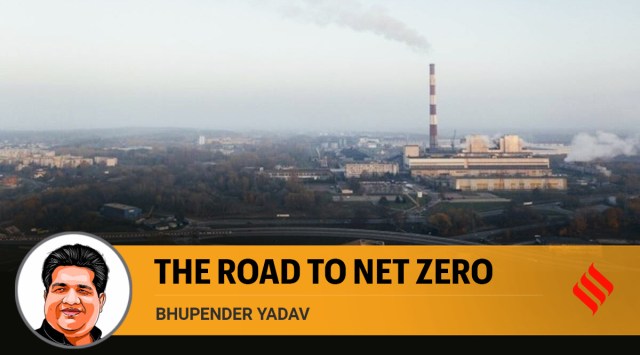- India
- International
A partnership to carry India into net-zero future
🔴 Bhupender Yadav writes: With active cooperation from the private sector, India will be able to help build a more sustainable world
 India’s renewable energy targets have steadily become more ambitious. (File)
India’s renewable energy targets have steadily become more ambitious. (File)If the world continues to move on the current path, global warming will be significantly more than 2°C by the end of the century. At a time when our planet faces an existential crisis, there is little doubt that we need innovative, scientific and urgent steps to secure humanity’s future.
We need to act decisively to reach global net-zero, restricting future cumulative emissions to the remaining carbon budget — as COP26 noted — if the rise in temperature is to remain within the limits of the Paris Agreement. It is in this spirit that, at COP26, Prime Minister Narendra Modi announced India’s enhanced climate commitments — the “Panchamrit”, including a commitment to reach net-zero by 2070. India’s announcement of its net-zero goal is a major step considering that our country is not the cause of global warming. Its historical cumulative emissions are a mere 4.37 per cent of the world’s total. At COP26 and other multilateral platforms, we have urged that developed countries must genuinely lead in mitigation, with their high capacities, their overwhelming contribution to historical cumulative emissions, and their current high per capita annual emissions.
India’s renewable energy targets have steadily become more ambitious, from the 175 GW by 2022 declared at Paris, to 450 GW by 2030 at the UN Climate Summit, and now 500 GW by 2030, announced at COP26. India has also announced the target of 50 per cent installed power generation capacity from non-fossil energy sources by 2030, raising the existing target of 40 per cent, which has already been almost achieved. India will not lag in terms of new cutting-edge renewable technologies and has already announced a Hydrogen Energy Mission for grey and green hydrogen. In energy efficiency, the market-based scheme of Perform, Achieve and Trade (PAT) has avoided 92 million tonnes of CO2 equivalent emissions during its first and second cycles.
India is accelerating its e-mobility transition with the Faster Adoption and Manufacturing of (Hybrid &) Electric Vehicles Scheme to support the electric vehicle market development and enable its manufacturing ecosystem to achieve self-sustenance. The government has also announced a slew of incentives for customers and companies to promote e-vehicles. India leapfrogged from Bharat Stage-IV (BS-IV) to Bharat Stage-VI (BS-VI) emission norms by April 1, 2020, the latter being originally scheduled for adoption in 2024. A voluntary vehicle scrapping policy to phase out old and unfit vehicles now complements these schemes. Indian Railways is charging ahead, targeting the full electrification of all broad-gauge routes by 2023.
In a striking global example in the deployment of clean energy, the Pradhan Mantri Ujjwala Yojana has benefitted 88 million households with LPG connections. More than 367 million LED bulbs have been distributed under the UJALA scheme, leading to energy savings of more than 47 billion units of electricity per year and a reduction of 38.6 million tonnes of CO2 per year. With these and many other initiatives, India has already achieved a reduction of 24 per cent in the emission intensity of its GDP between 2005 and 2016, and is on track to meet its target of 33 to 35 per cent by 2030. This target has now been enhanced to 45 per cent.

The role of the private sector is crucial to India’s journey along a credible pathway of low-carbon development to eventual net zero. Since industries also contribute to GHG emissions, any climate action will need to reduce or offset emissions that emerge from industrial and commercial activity. The public and private sectors in India are already playing a key role in meeting the climate challenge, helped by growing customer and investor awareness, as well as increasing regulatory and disclosure requirements. An increasing number of companies have announced sharply increased ambitions over the last year.
 Enterprises are well-positioned to not just adapt to but also gain from the low-carbon transition. This is especially true for enterprises that offer “green” solutions and those which assist communities in building resilience to the physical effects of climate change. Higher capital is expected to be directed toward companies at the forefront of the climate transition.
Enterprises are well-positioned to not just adapt to but also gain from the low-carbon transition. This is especially true for enterprises that offer “green” solutions and those which assist communities in building resilience to the physical effects of climate change. Higher capital is expected to be directed toward companies at the forefront of the climate transition.
Such a transition is relatively easier for companies operating in the services sector. With efficient use of energy across all their operations, expanding the use of renewable energy, and working with supply chain partners, service companies will be able to reduce emissions. Service companies can become carbon neutral by sourcing 50 per cent of their electricity from renewable sources.
The low-carbon transition challenge is bigger for companies that are largely coal-powered and contribute more than half of our country’s emissions. The business fraternity must make the best possible use of this opportunity to invest in climate technologies and expand the use of renewable energy sources.
The Indian cement industry has taken pioneering measures and achieved one of the biggest sectoral low carbon milestones worldwide. Indian industry partners have already undertaken ambitious actions. There is greater synergy of India’s climate policy with the actions and commitments of its private sector.
India’s journey on the low-carbon pathway towards net-zero requires the active participation of all stakeholders. Sustainable lifestyles and climate justice are at the core of this journey. With cooperation from the private sector, India will be able to responsibly use its fair share of the global carbon space and contribute to reaching the global net-zero goal to build a more environmentally sustainable planet.
This column first appeared in the print edition on January 5, 2021 under the title ‘The road to net zero’. The writer is Union Minister for Environment, Forest and Climate Change; and Labour & Employment. His book, The Rise of the BJP, will be released in January
EXPRESS OPINION
More Explained
Apr 20: Latest News
- 01
- 02
- 03
- 04
- 05










































